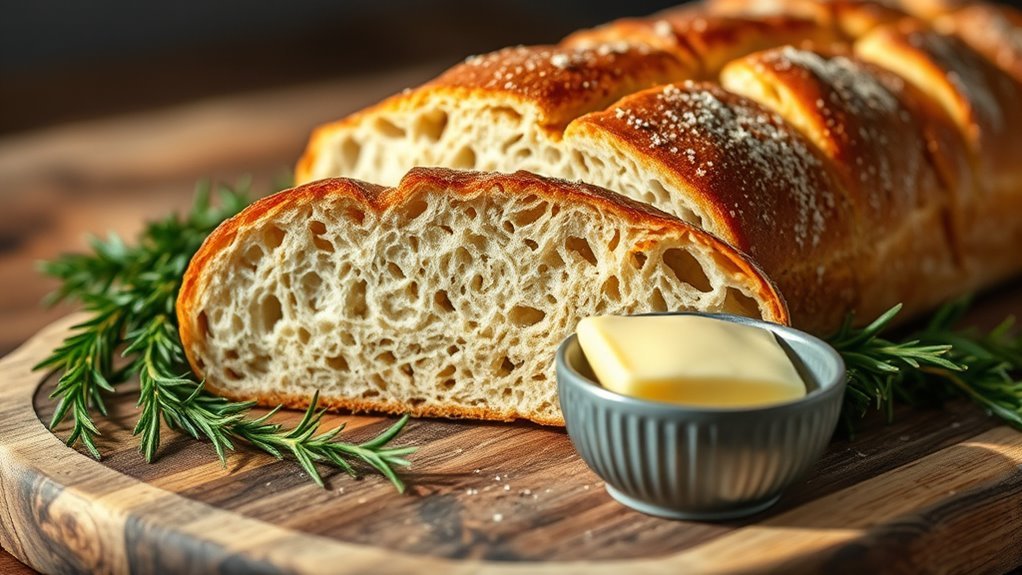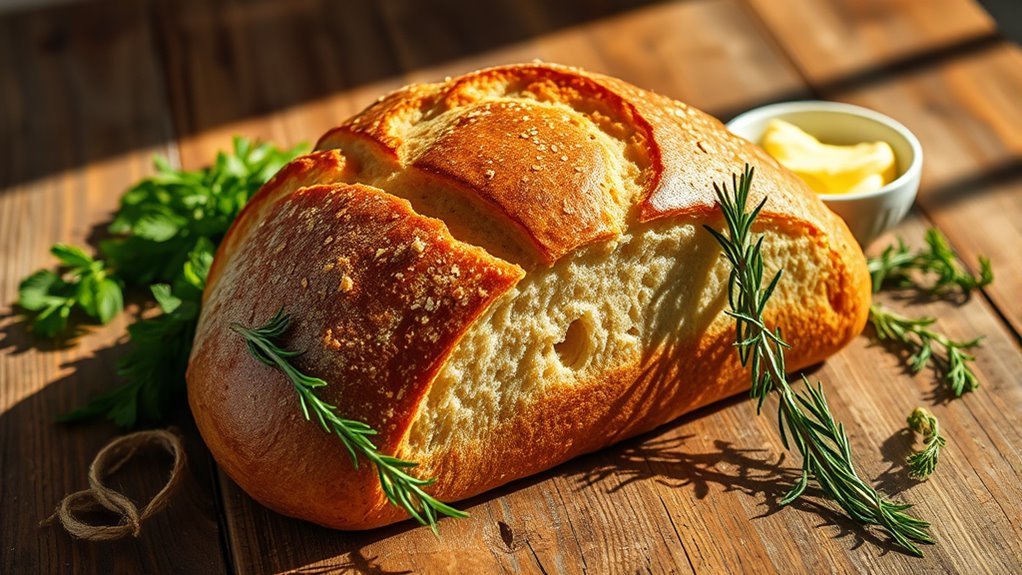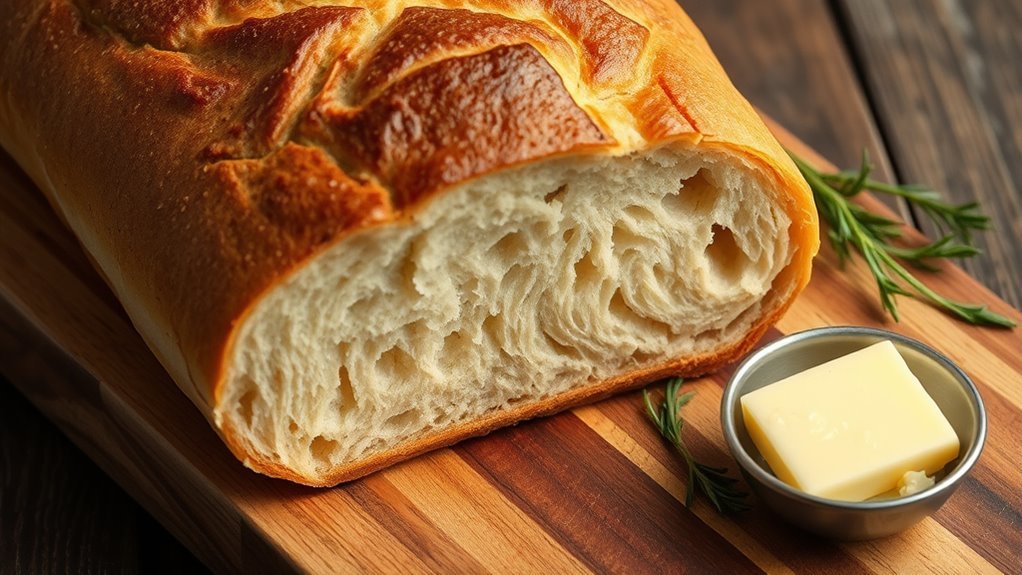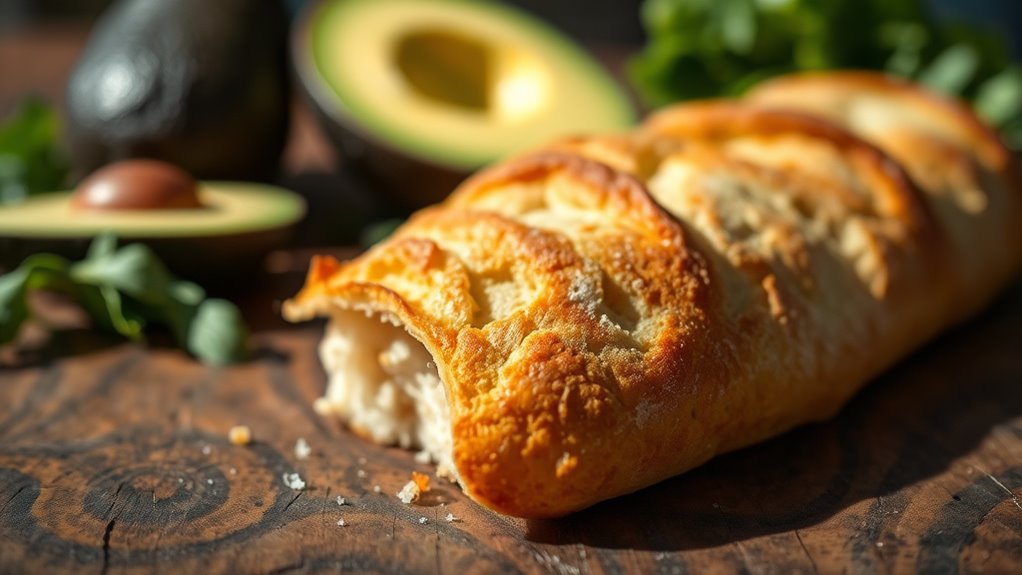Yes, Zea bread is keto-friendly. It’s made from low-carb ingredients like almond flour and psyllium husk, which help keep carb counts low while providing essential fiber. This bread supports your ketogenic goals by allowing you to enjoy a satisfying texture without derailing your diet. Plus, it’s gluten-free and nutrient-dense, making it a healthy choice overall. If you’re curious about how to incorporate it into your meals, you’ll find additional tips available.
Understanding the Ketogenic Diet

The ketogenic diet, often referred to as keto, is a high-fat, low-carbohydrate eating plan that aims to shift your body’s metabolism from burning glucose to burning fat for energy. Understanding the keto basics is vital if you’re considering this lifestyle. By drastically reducing your carb intake and increasing fats, you may enter a metabolic state called ketosis, where fat becomes your primary fuel source. However, dietary restrictions play a significant role in this process; you’ll need to avoid many traditional foods high in carbohydrates, such as bread, pasta, and sugar. Embracing keto can offer freedom from sugar cravings and stabilize energy levels, but it’s important to approach it mindfully and guarantee you’re getting a balanced intake of nutrients.
The Ingredients of Zea Bread

When considering Zea Bread, it’s important to examine its primary ingredients and how they contribute to its nutritional profile. You’ll find that the components play a vital role in determining whether this bread aligns with your keto goals. Understanding the nutritional content can help you make informed choices about incorporating it into your diet.
Primary Ingredients Overview
Understanding the primary ingredients of Zea Bread is essential for anyone considering its fit within a ketogenic diet. This bread boasts a unique blend that can offer various nutritional benefits. Here are the main ingredients you’ll find in Zea Bread:
- Almond Flour – Low in carbs and high in healthy fats.
- Psyllium Husk – A great source of fiber that aids digestion.
- Eggs – Provide protein and healthy fats, supporting satiety.
- Apple Cider Vinegar – Promotes gut health and may help regulate blood sugar.
Each ingredient plays a crucial role in maintaining the bread’s structure while aligning with keto principles. By understanding these components, you can make informed choices about incorporating Zea Bread into your diet.
Nutritional Content Analysis
To assess whether Zea Bread fits into your keto lifestyle, it’s important to look at its nutritional content. This bread typically contains almond flour, coconut flour, and psyllium husk, which serve as excellent fiber sources. These ingredients not only provide essential nutrients but also help keep your carb count low. When doing a calorie comparison, Zea Bread often has fewer calories than traditional bread, making it a suitable option for those watching their intake. However, it’s vital to check the specific brand’s nutrition label, as variations exist. Ultimately, if you’re seeking a keto-friendly alternative that satisfies cravings without derailing your goals, Zea Bread may be a viable choice to evaluate.
Nutritional Profile of Zea Bread

When considering Zea bread, it’s important to look at its ingredients and overall composition. The carb content analysis reveals how it fits into different dietary plans, especially for those monitoring their carbohydrate intake. Understanding these factors can help you determine if Zea bread aligns with your nutritional goals.
Ingredients and Composition
Zea bread’s nutritional profile is intriguing, especially for those following a ketogenic diet. When considering ingredient sourcing, it’s important to examine what’s in Zea bread. Here are some key components that contribute to its overall composition:
- Whole Grains: Often made from whole grain flour, which provides fiber and nutrients.
- Seeds and Nuts: Ingredients like flaxseeds and almonds enhance healthy fats and protein.
- Natural Sweeteners: May include alternatives like stevia or erythritol, suitable for low-carb diets.
- Binders: Ingredients such as psyllium husk or xanthan gum may be used for texture.
These elements are vital for dietary considerations, allowing you to enjoy Zea bread while maintaining your keto lifestyle.
Carb Content Analysis
While evaluating the carb content of Zea bread, you’ll find that it varies depending on the specific ingredients used. Generally, Zea bread incorporates whole grains, which serve as primary carb sources. If you’re following a low-carb or keto diet, it’s essential to examine the nutritional label closely. You’ll notice that some versions may contain added sugars or high-carb flours, which can conflict with dietary restrictions. A typical slice might range from 15 to 25 grams of carbohydrates, so keep this in mind when planning your meals. For those seeking low-carb options, consider alternatives or smaller portions of Zea bread. Ultimately, understanding the carb content empowers you to make informed choices that align with your dietary goals.
Carb Content and Its Implications
Although many people deem bread a staple in their diets, those following a ketogenic lifestyle must pay close attention to its carbohydrate content. Understanding the carb implications of Zea bread is vital if you want to stay within your dietary preferences. Here are some factors to take into account:
- Net Carbs: Total carbs minus fiber can impact ketosis.
- Serving Size: Portion control is essential to manage carb intake.
- Carbohydrate Sources: Ingredients in Zea bread can vary, affecting overall carb count.
- Dietary Goals: Align your bread choices with your keto objectives.
Potential Health Benefits of Zea Bread
When considering bread options, you might be surprised to learn that Zea bread offers several potential health benefits, particularly for those seeking alternatives to traditional high-carb varieties. Its unique ingredients can contribute positively to your digestive health, providing fiber that aids in gut function and helps maintain regularity.
| Health Benefit | Description |
|---|---|
| High Fiber Content | Supports digestive health and regularity |
| Low Glycemic Index | Helps maintain stable blood sugar levels |
| Nutrient Dense | Packed with vitamins and minerals |
| Gluten-Free Option | Suitable for those with gluten sensitivities |
Incorporating Zea bread into your diet could lead to a healthier lifestyle while satisfying your bread cravings without the guilt.
How to Incorporate Zea Bread Into a Keto Diet
Incorporating Zea bread into a keto diet can be a flavorful way to enjoy bread without exceeding your carbohydrate limits. Here are some ways you can do it:
- Zea Bread Recipes: Try low-carb recipes that use Zea bread as a base for sandwiches or toast, ensuring your toppings align with keto guidelines.
- Meal Prep: Plan your meals around Zea bread, using it in moderation to maintain your carb count for the day.
- Zea Bread Alternatives: Explore alternative ingredients that complement Zea bread, like avocado or nut butters, to enhance flavor while staying keto-friendly.
- Pair Wisely: Combine Zea bread with high-fat, low-carb foods to create balanced meals that satisfy your cravings without guilt.
Enjoy your freedom to indulge mindfully!
Frequently Asked Questions
Is Zea Bread Gluten-Free?
Zea bread is indeed gluten-free, making it a great option for those with gluten sensitivities. Its ingredients typically include a blend of alternative flours and seeds, which contribute to its unique texture and flavor. When you look at Zea bread nutrition, you’ll find it’s lower in carbs and higher in fiber compared to traditional bread. This can be a rejuvenating change if you’re seeking gluten-free options that still deliver on taste and health benefits.
Can I Freeze Zea Bread?
Ah, the age-old dilemma: to freeze or not to freeze? Well, you can definitely freeze Zea Bread! Just wrap it tightly in plastic wrap or aluminum foil, then place it in an airtight container. For ideal taste, try to consume it within three months. When you’re ready to savor its goodness, let it thaw at room temperature. These freezing tips can keep your bread fresh while you explore the wild world of storage methods! Enjoy!
How Long Does Zea Bread Last?
Zea bread typically lasts about 5 to 7 days when stored at room temperature in an airtight container. For ideal Zea bread freshness, keep it away from direct sunlight and moisture. If you want to extend its shelf life, consider freezing it; it can last up to 3 months in the freezer. Just remember to wrap it well to prevent freezer burn. Enjoy your bread while it’s at its best!
What Is the Serving Size for Zea Bread?
When considering the serving size for Zea Bread, it’s typically one slice, which offers a balanced portion for most diets. You’ll want to check the nutritional information on the package, as it can vary slightly based on the specific type of bread. Generally, one slice contains essential nutrients that can complement your meals while allowing for flexibility in your diet. Remember, moderation is key, and knowing your serving size helps maintain that balance.
Is Zea Bread Suitable for Diabetics?
Imagine a bridge between your cravings and health—Zea bread can be that bridge for diabetics. Its unique ingredients, like whole grains and seeds, offer essential nutrients while potentially stabilizing blood sugar levels. The benefits of Zea bread include a lower glycemic index, making it a suitable choice in moderation. However, it’s vital to consult with your healthcare provider to guarantee it aligns with your personal dietary needs and goals for maximum freedom in eating.


